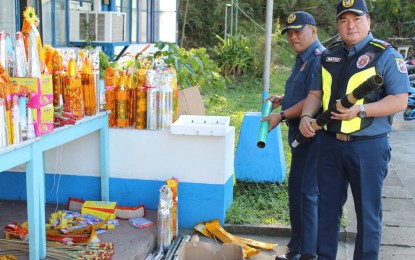
‘BOGA’. Policemen hold a homemade cannon known as boga confiscated during the holiday season in Tacloban City. The Department of Health (DOH) Eastern Visayas on Tuesday (Jan. 7, 2020) reported that most injuries during the holiday revelries in Eastern Visayas were related boga, an alternative noisemaker commonly made of PVC pipes or empty tin cans. (Photo courtesy of Tacloban City police office)
PALO, Leyte -- The use of “boga” or homemade cannons has been tagged as the most common cause of injuries during the holiday season in Eastern Visayas, the Department of Health (DOH) reported on Tuesday.
The DOH recorded a total of 15 firecracker-related injuries, with three cases due to the use of boga; followed by kwitis, five star, whistle bomb, recycled firecracker powder with two victims each; and binggala and piccolo with one victim each. There are two other wounded from unknown firecrackers.
The figure is 66 percent lower than last year’s 44 recorded injuries within the same reporting period.
DOH Eastern Visayas regional director Minerva Molon said the first two reported firecracker injuries in the region were related to boga which is why she immediately ordered her staff to come up with an advisory.
“All reported cases were only minor injuries without amputation. The use of boga to make noise is something that we strongly discouraged,” Molon said in a press briefing.
The alternative noisemaker is commonly made of PVC pipes or empty tin cans, popular among adults and children in rural communities.
The combination of air and flammable fuel in the pipe's enclosed space when ignited by a spark from the trigger mechanism or by small fire causes a loud, booming sound.
Of all the firecracker victims in the region, seven had eye injuries while eight suffered from minor burns. The youngest victim is six years old and the eldest is 36.
The victims, 11 males and four females, were treated in their respective rural health units and provincial hospitals, while two were admitted at the Eastern Visayas Regional Medical Center in Tacloban City.
Molon acknowledged the coordinated efforts of all the stakeholders especially the Philippine National Police, the Bureau of Fire Protection, and the members of media for the efficient implementation of Iwas Paputok program.
“Although we did not achieve the zero target, this is still a big achievement for us. We will continue to improve and strengthen this campaign and focus on the prohibited pyrotechnic devices such as boga,” Molon added.
In June 2017, President Rodrigo Duterte signed Executive Order (EO) 28 provides for the regulation and control of the use of firecrackers and other pyrotechnic devices.
In the region, the consistent reduction of firecracker-related injuries has been recorded since the implementation of EO 28 from 106 cases in 2017, 44 in 2018, 44 in 2019, to only 15 this year.
The DOH started its yearly surveillance on Dec. 21, 2019 until Jan. 6, 2020. (PNA)
